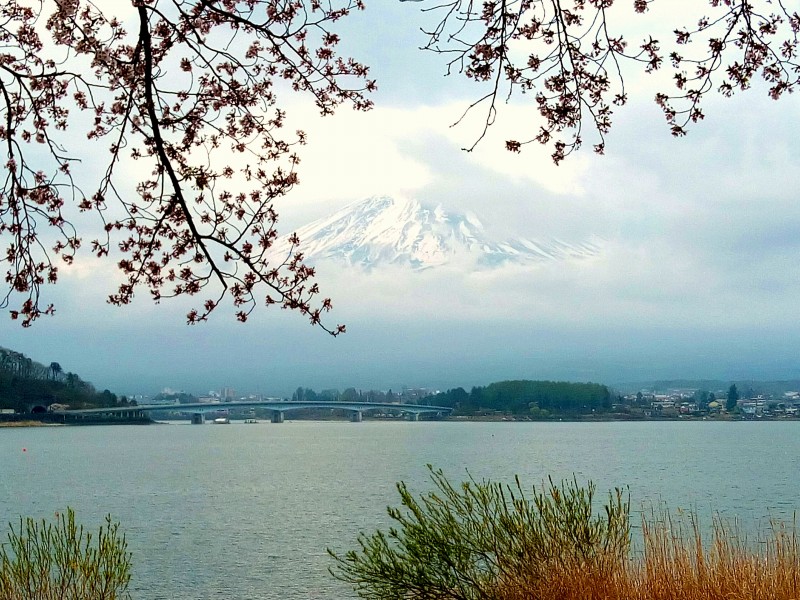April 24 – 27: Shimizu, Shizuoka, Shuzenji, Mishima, Atami & Tokyo
April 24 Wednesday: Lake Kawaguchiko, Shimizu & Shizuoka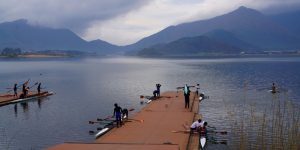
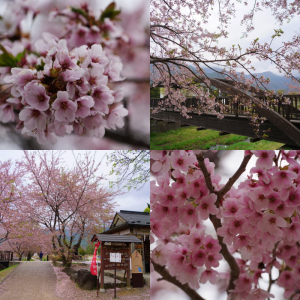 I was determined to see the cherry blossoms on the northern shore before leaving. The weather forecast was not good but I still went out for a walk shortly after 5:30 am. Soon I suddenly saw Mt. Fuji emerging behind clouds. Soon it was gone!
I was determined to see the cherry blossoms on the northern shore before leaving. The weather forecast was not good but I still went out for a walk shortly after 5:30 am. Soon I suddenly saw Mt. Fuji emerging behind clouds. Soon it was gone!
I walked across the bridge and passed Ubuyagasaki Peninsula which is also another good spot for photos. I watched young rowers practising on the lake.
Soon, I arrived at the Kawaguchiko Musem that I visited in 2016. The lakeshore was beautiful lined with cherry trees in full blossom.
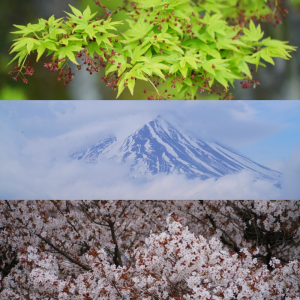 I continued till I reached the park in front of the Music Forest Museum. This is indeed a great spot for photography. I ran into a young couple from Hong Kong taking wedding photos.
I continued till I reached the park in front of the Music Forest Museum. This is indeed a great spot for photography. I ran into a young couple from Hong Kong taking wedding photos.
Then I saw Mt. Fuji appearing for the second time this morning. I took a few photos before it disappeared.
After a wonderful 2-hour walk, I was back in the hotel by 8 am. The hotel provides a free shuttle to the bus/train station. The tourist office had advised me to take bus S4 at 9:05 am to Fuji station where I could take a train to Shimizu where I had booked a room for the night.
Unfortunately, I was not told that I had to get off at Fujinomiya in order to get a train to Fuji station. As a result, I did not get off till I was at the terminal outside the Shinkanshen Shin-Fuji Station. The tourist office lady here told me to take S4 heading to Kawaguchiko at 11:45 am and get off at Fujinomiya. As a result, I wasted over two hours travelling to and fro between Fujinomiya and Shin-Fuji.
By the time I arrived at Fujinomiya station, I missed a direct train at 12:22pm to Shimizu. As a result, I had to take a local train at 12:42pm to Fuji Station and then change for another train to Shimizu.
I was annoyed at first. Immediately, I told myself that I had time and it was my fault not to double check. Another lesson to be learnt!
It was after 2 pm when I arrived in Shimizu. The weather was bad with heavy rain. Luckily, I had an umbrella in my suitcase.
As I could not check in till 3 pm, I went off to the Shimizu Fish market Kashinoichi by the harbour for a sumptuous sashimi lunch for ¥1,200.
What next? I hopped on the train heading south to Shizuoka 静岡市, the capital city of Shizuoka Prefecture.
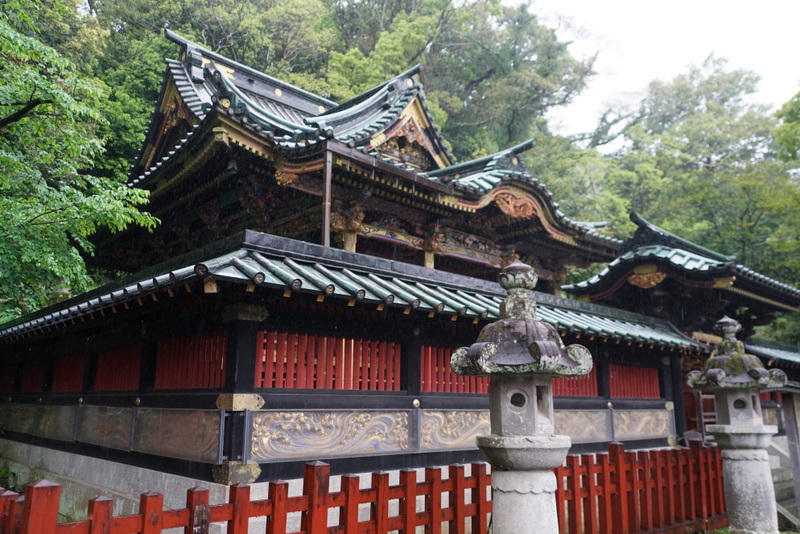 I got a map from the tourist office which advised to visit the Sengen Shrine. I followed her advice and took a bus as it was still raining.
I got a map from the tourist office which advised to visit the Sengen Shrine. I followed her advice and took a bus as it was still raining.
This shrine covers a large area at the foot of Mount Shizuhata. It has a long history: worshipped as the Suruga Province Soja, it received the veneration of Tokugawa in the Edo era.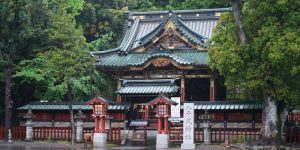
This shrine is the name for a collective group of three main shrines namely the Kambe Shrine, Sengen Shrine and Ohtoshimioya Shrine and four subsidiary shrines. Today, the 26 buildings have been designated as a national important cultural property. The grand exquisite buildings of the three shrines are richly coloured in urushi coating.
I followed a walking trail which led me to an excavated burial mound from the Kofun period (古墳時代 – an era in the history of Japan from about 300 to 538 AD).
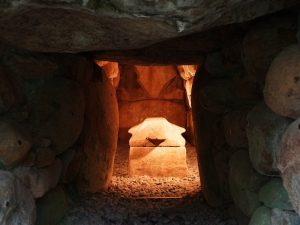 I loved to continue to the top. But it was raining and the path was slippery and muddy. I saw no one on the path leading to the hill top. Safety is always of paramount importance: it can be fatal if I fall in a such a deserted place. I turned back.
I loved to continue to the top. But it was raining and the path was slippery and muddy. I saw no one on the path leading to the hill top. Safety is always of paramount importance: it can be fatal if I fall in a such a deserted place. I turned back.
After spending an hour looking around, I followed the main road leading to the station. On the way, I passed the Sumpu Castle built by Tokugawa Ieyasu in 1585. The East Gate and the Tatsumi Yagura Turrent have been restored.
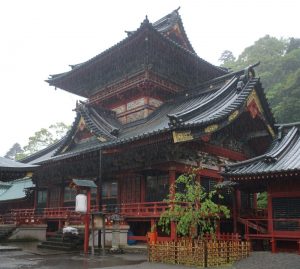 I did not bother to take my camera out to take photos. Shizuoka looks tidy but a bit dull especially on a grey rainy day. The countless eateries around the station liven up the place.
I did not bother to take my camera out to take photos. Shizuoka looks tidy but a bit dull especially on a grey rainy day. The countless eateries around the station liven up the place.
I was soon back in Shimizu which is quiet and small. I felt a bit bored for the first time on this trip. I went out looking for something to eat though I was not hungry. I found an izakaya opposite my hotel and had a most delicious grilled chicken thigh cooked with balsamic vinegar and herb and a craft beer for ¥1,670. Izakaya is a Japanese institution where men loiter after work. Looking around, I saw this izakaya was patronised mainly by young people. Izakaya is no longer men’s haven: four young ladies sat behind me drinking and laughing heartily.
April 25 Wednesday: Miho – Shuzenji – Mishima – Atami
I have come to Shimizu after reading about the Miho seacoast, a World Heritage site famed for its pine grove and a majestic view of Mt. Fuji in front, Izu Peninsula to the east and Omaezaki peninsula to the west.
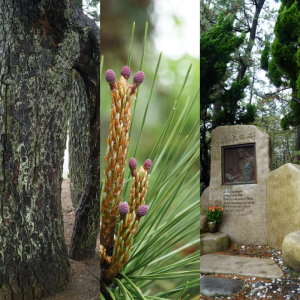 The best time to see clear Mt. Fuji would be from late November to early March. As it was still drizzling when I left the hotel before 8 am, I of course did not see Mt. Fuji while walking along this black sand beach which stretching over 7km.
The best time to see clear Mt. Fuji would be from late November to early March. As it was still drizzling when I left the hotel before 8 am, I of course did not see Mt. Fuji while walking along this black sand beach which stretching over 7km.
I took a local bus to the coast and then strolled in the park for over ah hour. It rained when I began my walk. When the rain stopped, I watched mountains at Izu Peninsula drifting through clouds and mist. Countless small fishing boats dotted the bay. The air was fresh with the scent of pine trees. It was beautiful and atmospheric.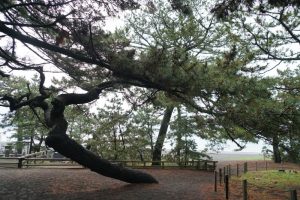
The weather improved and the sun came out. I walked through the Tenninmori Park all the way to Miho Lighthouse. I spent a while walking through a built-up area before I was back on the main road to catch a bus to the station.
I picked up my suitcase from the hotel which is about 5 minutes’ walk from the station. Around 11 am, I was on the train heading to Mishima. I left my suitcase in a locker (¥600) before taking the Izuhakone Railway to Shuzenji修善寺. One can travel from Tokyo all the way to here too.
When I got off the train at around 1 pm, I took a local bus (¥180) to my destination which is about 2.5 km away. It was too hot to walk.
Many Japanese come here for the onsen, which is one of the oldest and most famous hot spring resort towns on the Izu Peninsula. It was named after the Shuzenji Temple which is said to be founded by Kobo Daishi in the 9th century.
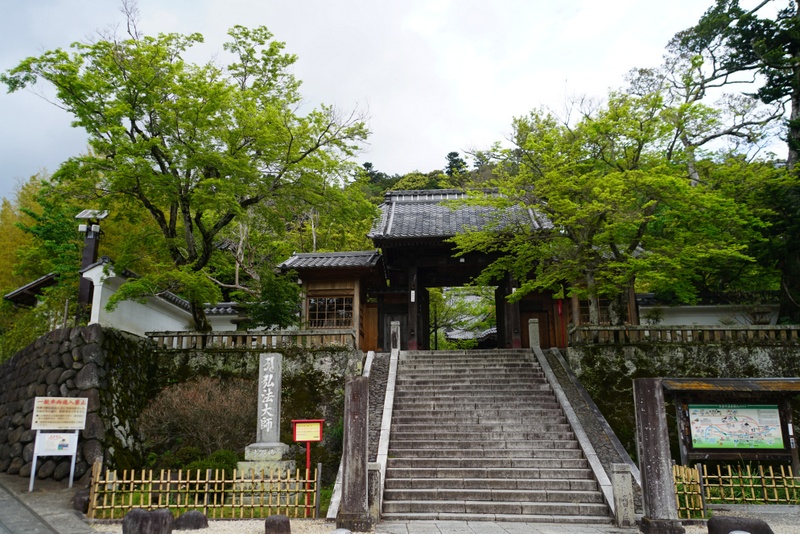
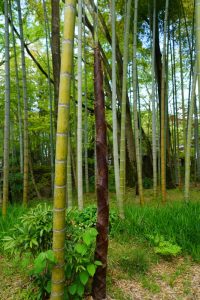 The temple was supported by the Hojo family in the Kamakura period and has been scene of tragedies. The shogun Minamoto no Yoritomo arrested his brother Minamoto no Noriyori in 1194 and confined him here. The second shogun Yoriie, the first son of Minamoto no Yoritomo, who was confined here because of a plot by his mother and grandfather. He was eventually assassinated.
The temple was supported by the Hojo family in the Kamakura period and has been scene of tragedies. The shogun Minamoto no Yoritomo arrested his brother Minamoto no Noriyori in 1194 and confined him here. The second shogun Yoriie, the first son of Minamoto no Yoritomo, who was confined here because of a plot by his mother and grandfather. He was eventually assassinated.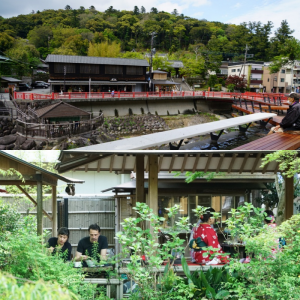
Today, it is a Zen Buddhist temple where visitors can participate in meditation classes.
Apart from the temple, there are several historic ryokans, a small but beautiful and tranquil bamboo grove, a couple of public foot baths and nice shops and eateries.
I followed a walking path. The hilly area must be beautiful in autumn. There was a photo exhibition with a Zen feel. The photos of the lotus flowers are artistical and soothing.
Before leaving, I soaked my tired feet in the oldest foot bath in the middle of the river while having an ice cream. What a relaxing day!
When I was leaving the foot bath, I found a notice board saying that the water is holy and should not be touched. I felt very bad as I had not seen this notice. I hope Kobo Daishi would forgive me!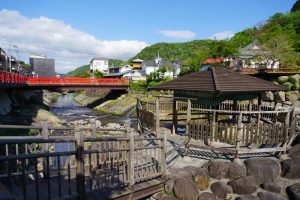
The last place to visit today was Mishima 三島市which symbolic bird is kingfisher. I got a tourist map from the Tourist Office and followed a recommended 5-km walk for about two hours.
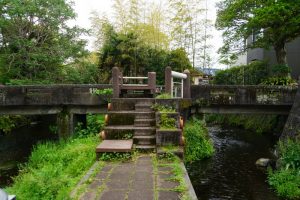 The city is lovely and green with several rivers running through it. The part of the walk I enjoyed most is the trail along the Genbe Gawa (1.5km river from Kohama-Ike in Rakujuen) which eventually flows into Nakazato-Onsuichi (reservoir) The river is crystal clear and the area along it is now a riverside park. The whole area is lush green with flowers, trees, weeds, waterfowls, birds etc
The city is lovely and green with several rivers running through it. The part of the walk I enjoyed most is the trail along the Genbe Gawa (1.5km river from Kohama-Ike in Rakujuen) which eventually flows into Nakazato-Onsuichi (reservoir) The river is crystal clear and the area along it is now a riverside park. The whole area is lush green with flowers, trees, weeds, waterfowls, birds etc
I followed the river and walked past the Mizu-no-Sono-Ryokuchi (park) before turning east. I soon arrived at the Sano Art Museum. It was 5 pm and the museum was closed.
It was time to turn north and head back to the train station. I spent a while at the Mishima Taisha 三嶋大社which covers an expansive large ground with many old trees. The Honden, a three-bay nagare–zukuri style building, has been reconstructed numerous times. The current one dates from 1866 after the shrine was flattened in an earthquake in 1854.
I followed a path along Goton-Gawa to Komo-Ike-Koen (park). Soon I am back at the station just after 6pm.
Atami 熱海市 is only a few stops from Mishima. I came here as it is the last train stop my mini pass could take me. From here, I could get a train to Tokyo for just under ¥2,000: this is the cheapest way to reach Tokyo.
I had dinner in a dumpling restaurant chain. The food is quite good with big portion. I must have over-eaten and felt bloated. I took a taxi to Onsen Hostel Hinoemi for ¥700. I shared a spacious Japanese-styled room with three futon beds and toilet with two interesting roommates. The young nurse comes from Sweden while the Japanese lady Aki has returned from the UK to settle down in her motherland again.
After settling down in the hostel, I began to have diarrhea and vomiting. What was wrong? Was it the sashimi or chicken I had last night or the dumplings I had for dinner a few hours ago? I did not know. I went to the toilet three times before going to bed.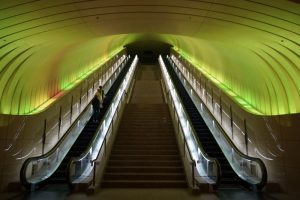
April 26 Thursday: Atami – Ueno, Tokyo
It was raining when I got up after an excellent sleep. I looked out of the window and found the town centre, the rugged coastline and Hatsushima, an island off Atami veiled in mist.
I had a nice Japanese cum western-style buffet in the hostel. The open and well-equipped kitchen, dining cum common room are located on the second floor with full sea view. It was so nice that I sat in front of the window enjoying a cup of coffee till the kitchen closed at 10 am. I still had diarrhoea and rushed to the toilet a couple of times in the morning. I checked out but left my suitcase at the reception.
 The only place I planned to visit was the Museum of Art (MOA) which was presenting a special exhibition on “Hokusai Manga and the Thirty-six Views of Mt. Fuji”. MOA is only 15 minutes’ walk (but all uphill) from the hostel. It was raining and the air was crisp and fresh. I enjoyed my morning exercise.
The only place I planned to visit was the Museum of Art (MOA) which was presenting a special exhibition on “Hokusai Manga and the Thirty-six Views of Mt. Fuji”. MOA is only 15 minutes’ walk (but all uphill) from the hostel. It was raining and the air was crisp and fresh. I enjoyed my morning exercise.
Katsushika Hokusai (1760-1849) born in Edo (present day Tokyo), is the most famous Japanese artist, ukiyo-e painter and printmaker of the Edo period. He was observant, perceptive, creative and productive.
Hokusai began painting around the age of six and had a long and successful career. He created the Hokusai Manga and various etethon or art manuals in 1811. His monumental and most popular woodblock print series of Thirty-six Views of Mount Fuji was created between 1826 and 1833 as a response to a domestic travel bloom and as part of his obsession with Mt. Fuji. He is also responsible for the 1834 One Hundred Views of Mount Fuji, a work which has been considered the masterpiece among his landscape picture books. His largest works is the 15-volume collection of Hokusai Manga published in 1814 with nearly 4,000 sketches.
I paid an entrance fee of ¥1,600 and ¥500 for an audio guide. I had a most wonderful discovery journey that enables me to see Mt. Fuji, the landscape and daily life during the Edo period through Hokusai’s eye.
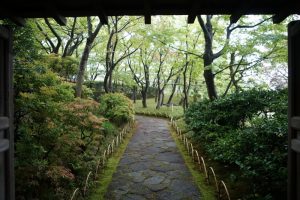 I was captivated by the forces of his stroke especially when looking at his internationally iconic print, The Great Wave off Kanagawa. But I am more amazed by the composition of his prints and how he bought to life in a most vivid manner the daily life of peasants, craftsmen, merchants and fishermen. In one print, he showed the back of tourists looking at Mt. Fuji. Hokusai is a great master.
I was captivated by the forces of his stroke especially when looking at his internationally iconic print, The Great Wave off Kanagawa. But I am more amazed by the composition of his prints and how he bought to life in a most vivid manner the daily life of peasants, craftsmen, merchants and fishermen. In one print, he showed the back of tourists looking at Mt. Fuji. Hokusai is a great master.
Apart from the exhibition, I enjoy the architecture and lighting of the building and the views of Atami and the sea from the garden.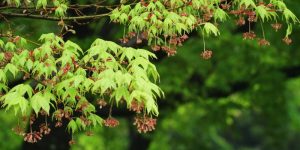
It was almost 2 pm when I went to the Japanese restaurant housed in an old house next to the museum. All guests had left and I had the whole place for myself. I ordered a red bean desert and stayed for almost an hour enjoying the view of the Japanese garden outside.
The rain had stopped. I gazed at the pine trees and the stone garden with dripping rain drops while enjoying my dessert. It is so peaceful and calm.
It was after 3 pm when I returned to the hostel to pick up my suitcase. The receptionist told me to follow a shortcut which would take me to the station in less than 15 minutes. It is an easy downhill path.
I took the 3:49 pm train and arrived at Ueno Station two hours later. I stayed at APA hotel close to the train station at a reasonable rate of about ¥8,000 a night.
I was ready for dinner. The area in front of the station is full of restaurants and pubs. I saw a popular eatery with grilled tuna collar. I went in and had a big tuna collar and a beer for ¥1,700. Tuna is fatty and meaty. For the second time, I did not feel well as my stomach seemed bloated even before I finished the collar. I had the same problem when I was in Tsujima after having a grilled fatty beef stewer. I must be careful in future. My diarrhoea problem was not over yet. But I survived.
April 27 Saturday: Tokyo
I was in Tokyo for two nights in 2016 after the Mt. Fuji climb. The Greater Tokyo Area is the most populous metropolitan area in the world with a population of over 38 40 million. There is a lot to see. I therefore used Ueno as a base to explore temples, visit a few museums and the Ashikaga Flower Show.
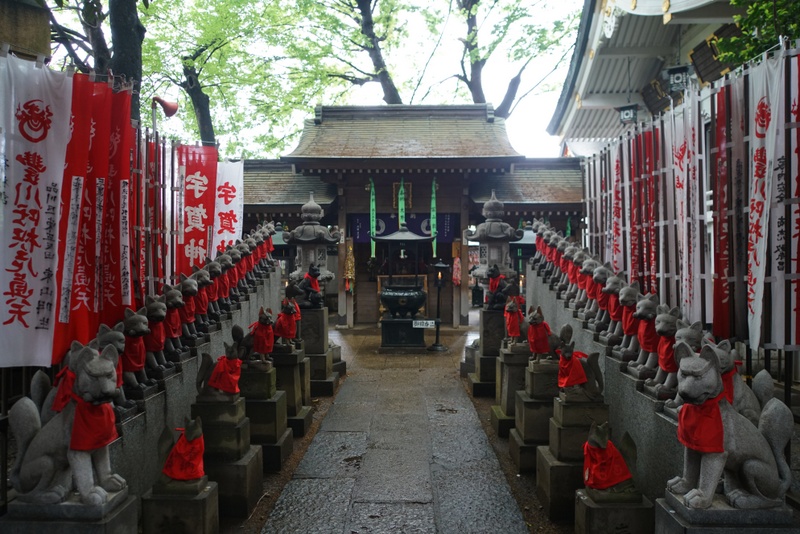 After buying a 48-hour metro pass for ¥1,200, I took the metro to Akasaka and walked to Toyokawa Inari Tokyo Betsuin 豊川稲荷東京別院, a Buddhist temple originally built in 1828 as a branch temple of the main Toyokawa Inari Temple in Toyokawa City.
After buying a 48-hour metro pass for ¥1,200, I took the metro to Akasaka and walked to Toyokawa Inari Tokyo Betsuin 豊川稲荷東京別院, a Buddhist temple originally built in 1828 as a branch temple of the main Toyokawa Inari Temple in Toyokawa City.
Inari is the Shinto deity of rice. Legend has it that the third son of Emperor Juntoku underwent a spiritual experience in which deity Dakini-Shinten appeared on the back of a white fox with a rice plant slung over his back. The prince embodied this experience into the statue of Dakini-Shinten which is now enshrines in this temple which belongs to the Soto sect of Buddhism.
There are many statues of different deities packed in a small temple ground. This shrine here is known for countless statues of foxes which creates very queer and unique atmosphere.
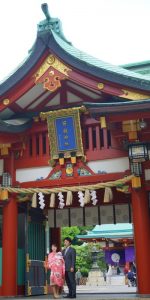
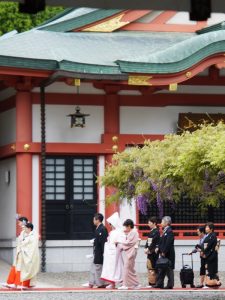 My next stop was the Hie Shrine 日枝神社 a popular spot for Instagram. I had a leisure stroll and soon found myself at the bottom of a picturesque tunnel of torii gates. Some foreign tourists spent ages in taking photos.
My next stop was the Hie Shrine 日枝神社 a popular spot for Instagram. I had a leisure stroll and soon found myself at the bottom of a picturesque tunnel of torii gates. Some foreign tourists spent ages in taking photos.
The shrine located on a hill top is known for its divine favour of love knot, marriage ties and easy delivery of children. I saw my first wisteria in Tokyo here.
I spent over half an hour watching two couples getting married. The couple with their family first took photos at the right-hand corner of the main hall. Then the party followed a path leading to the main hall where the ceremony was held. I stood outside watching the solemn ceremony conducted by a Shinto priest in the presence of the two families.
On the way to the metro station, I saw the National Diet Building and walked past the APA Pride Hotel which looks quiet and luxurious (as compared with the one I stayed near Ueno). As I had to find a toilet, I decided to go in to take an early lunch at the café and check out this hotel. I may return one day and stay here which is peaceful and affordable. I had a delicious fish set for less than ¥1,500. Great value!
Ueno Park 上野公園
The first time I was in Ueno was in 1990s. The park grounds were originally part of Kanei-ji with some 30 buildings. The temple used to be one of the city’s largest and wealthiest temples and a family temple of the ruling Tokugawa clan during the Edo Period (1603-1868). Kaneiji’s five-story pagoda and the Ueno Toshogu shrine were amongst the gems of the old temple enclosure which remain intact since the end of the Tokugawa shogunate. The temple grounds were converted into one of Japan’s first western style parks and opened to the public in 1873 after the shogunate was overthrown.
The Park houses several museums including the Tokyo National Museum, National Museum for Western Art Museum, Tokyo Metropolitan Art Museum and National Science Museum, the Ueno Zoo, a couple of temples and shrine namely the Kaneiji Temple, Kiyomizu Kannon Temple, Toshogu Shrine and Bentendo. It is a popular spot for cherry blossoms.
I spent the afternoon in the National Museum of Western Art (NMWA) which was presenting two special exhibitions namely “Upon the 60th Anniversary of the NMWA Le Corbusier and the Age of Purism” and “Hayashi Tadamasa: The Paris Art Dealer who Promoted Japonisme” from February 19 to May 19, 2019.
Built to house the collection of works gathered by the industrialist Matsukata Kojiro (1865-1950) between 1920 and 1923, NMWA was designed by a Swiss-French architect Charles- Edouard Jeanneret- Gris (1887-1965) who is known world-wide as Le Corbusier. He was also a designer, painter, urban planner and writer and one of the pioneers of modern architecture. As a painter, he together with Amédée Ozenfant formed the new Purism movement in 1918.
Le Corbusier was an avant garde. In 1925 he declared in ‘The Decorative Art of Today’ that in future the decorative arts industry would produce only “objects which are perfectly useful, convenient, and have a true luxury which pleases our spirit by their elegance and the purity of their execution, and the efficiency of their services. This rational perfection and precise determinate create the link sufficient to recognize as a style”.
As an architect, he began constructing a few villas in the late 1920s. In 1927, he published the principles of his new architecture in “The Five Points of a Modern Architecture”. The five points are the pylons, the roof terrace, the free plan, the ribbon window and the free façade.
Dedicated to providing better living conditions for residents of crowded cities, Le Corbusier had put forward urban design concepts and plans. The master plan for the city of Chandigarh in India which I visited in 1980 was prepared by him.
NMWA completed in March 1959 was a symbol of the resumption of diplomatic ties between Japan and France after WWII. France returned the art works collected by Matsukata Kojiro that had remained in England and France. The famed building is Le Corbusier’s only representative example of his work in the Far East and has been together with his 16 other works listed as a World Heritage Site as “The Architectural Work of Le Corbusier, an Outstanding Contribution to the Modern Movement by UNESCO in 2016.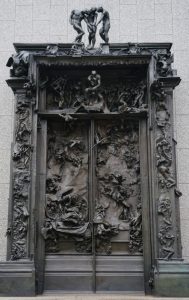
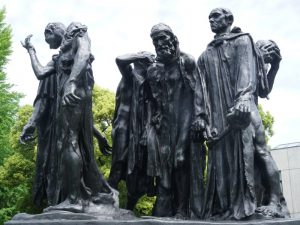 The museum housing about 4,500 works including examples of painting, drawing, print and sculpture from the 14th to the beginning of the 20th centuries. The garden is adorned by Auguste Rodin’s monumental sculptures. I paid an entrance fee of ¥1,600 and ¥500 for an audio guide Though I have seen his works in other parts of the world, I know little about him and his life. The exhibition which is meticulously curated and presented in the usual Japanese perfectionist way, is an excellent introduction for me.
The museum housing about 4,500 works including examples of painting, drawing, print and sculpture from the 14th to the beginning of the 20th centuries. The garden is adorned by Auguste Rodin’s monumental sculptures. I paid an entrance fee of ¥1,600 and ¥500 for an audio guide Though I have seen his works in other parts of the world, I know little about him and his life. The exhibition which is meticulously curated and presented in the usual Japanese perfectionist way, is an excellent introduction for me.
The exhibition includes works showcasing his talents as an architect, a painter, and a designer. I saw for the first time his paintings from his Purist and later periods. The model of a few villas designed in 1920s and masterplans for cities were on displayed. Despite of the passage of almost a century, his villas still look modern and beautiful. I am impressed by his philosophy about urban planning and design.
I took a quick look at the exhibition on the Hayashi Tadamasa (1853-1906) who first went to Paris in 1878 as a translator and then began his career as an art dealer. In 1900, he was a general commissioner of the Japanese art section at the World Fair in Paris. He introduced Japanese paintings, craft and ukiyo-e prints to Europe and became a driving force in the rise of Japonisme.
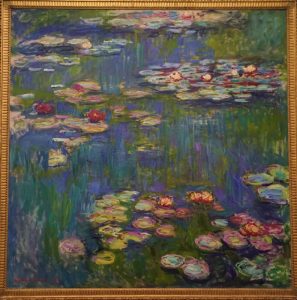 I saw a small permanent collection of the 19th – 20th century paintings and sculpture on the way out. The museum has a fantastic collection of impressionist paintings including the Water Lilies by Claude Monet.
I saw a small permanent collection of the 19th – 20th century paintings and sculpture on the way out. The museum has a fantastic collection of impressionist paintings including the Water Lilies by Claude Monet.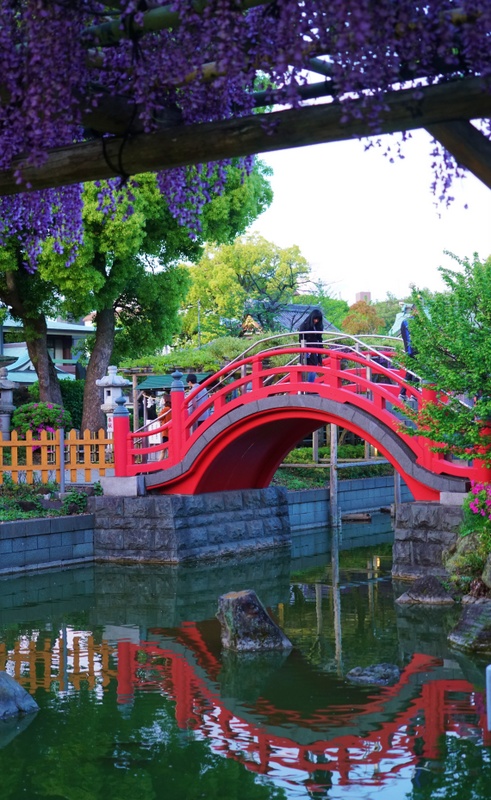
After having spent the whole afternoon in NMWA, I had to return to the hotel as I was still troubled by diarrhea.
When I felt better, I made my way to Kameido Tenjin Shrine 亀戸天神社 which is a great spot for wisteria viewing in Tokyo. The historic shrine site with an elegant and peaceful scenery by the pond and the vermilion arch bridge provide a photogenic setting for some 100 wisterias.
I should have taken a direct bus to the shrine which is not too far from Ueno. Instead, I used my metro pass, took a JR train and then walked for some 15 minutes. I was foolish and did not arrive till 5:30pm.
It had been cloudy in the afternoon. Miraculously, the sky suddenly cleared up enough to allow the sunray lighting up the wisteria in front of me by the pond. I took some photos before the sunlight was gone.
Around 6 pm, the temple ground was lit up. The scenery and atmosphere changed. I watched illuminated wisterias for the first time in my life.
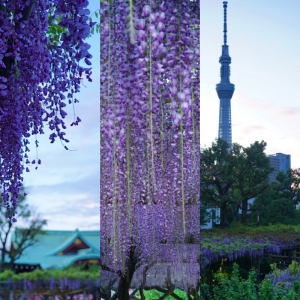 Many photographers set up their tripod to capture the wisterias with reflections and the Tokyo Skytree which is about 2.5 km away, on its background.
Many photographers set up their tripod to capture the wisterias with reflections and the Tokyo Skytree which is about 2.5 km away, on its background.
There were too many visitors for this small temple ground. I could hardly move without getting into someone’s way. It was impossible to enjoy in solitude the elegant flowers with reflections in the pond.
I was bothered by diarrhoea the whole day. So, I skipped dinner to give my stomach a rest.


